INTERNATIONAL
STANDARD
ISO
11452-1
Third edition
2005-02-01
Road vehicles — Component test
methods for electrical disturbances from
narrowband radiated electromagnetic
energy —
Part 1:
General principles and terminology
Véhicules routiers — Méthodes d'essai d'un équipement soumis à des
perturbations électriques par rayonnement d'énergie électromagnétique
en bande étroite —
Partie 1: Principes généraux et terminologie
Reference number
ISO 11452-1:2005(E)
© ISO 2005
Copyright International Organization for Standardization Reproduced by IHS under license with ISO Not for ResaleNo reproduction or networking permitted without license from IHS--`,,,``,-`-`,,`,,`,`,,`---�
ISO 11452-1:2005(E)
PDF disclaimer
This PDF file may contain embedded typefaces. In accordance with Adobe's licensing policy, this file may be printed or viewed but
shall not be edited unless the typefaces which are embedded are licensed to and installed on the computer performing the editing. In
downloading this file, parties accept therein the responsibility of not infringing Adobe's licensing policy. The ISO Central Secretariat
accepts no liability in this area.
Adobe is a trademark of Adobe Systems Incorporated.
Details of the software products used to create this PDF file can be found in the General Info relative to the file; the PDF-creation
parameters were optimized for printing. Every care has been taken to ensure that the file is suitable for use by ISO member bodies. In
the unlikely event that a problem relating to it is found, please inform the Central Secretariat at the address given below.
© ISO 2005
All rights reserved. Unless otherwise specified, no part of this publication may be reproduced or utilized in any form or by any means,
electronic or mechanical, including photocopying and microfilm, without permission in writing from either ISO at the address below or
ISO's member body in the country of the requester.
ISO copyright office
Case postale 56 • CH-1211 Geneva 20
Tel. + 41 22 749 01 11
Fax + 41 22 749 09 47
E-mail copyright@iso.org
Web www.iso.org
Published in Switzerland
ii
© ISO 2005 – All rights reserved
Copyright International Organization for Standardization Reproduced by IHS under license with ISO Not for ResaleNo reproduction or networking permitted without license from IHS--`,,,``,-`-`,,`,,`,`,,`---�
ISO 11452-1:2005(E)
Contents
Page
Foreword............................................................................................................................................................ iv
Introduction ........................................................................................................................................................ v
Scope...................................................................................................................................................... 1
1
2
Terms and definitions........................................................................................................................... 1
General aim and practical use ............................................................................................................. 5
3
General test conditions ........................................................................................................................ 6
4
5
Instrumentation ..................................................................................................................................... 9
6
Test procedure .................................................................................................................................... 10
Annex A (normative) Functional performance status classification (FPSC) ............................................. 13
Annex B (informative) Constant peak test level ............................................................................................ 16
Bibliography ..................................................................................................................................................... 19
© ISO 2005 – All rights reserved
iii
Copyright International Organization for Standardization Reproduced by IHS under license with ISO Not for ResaleNo reproduction or networking permitted without license from IHS--`,,,``,-`-`,,`,,`,`,,`---�
ISO 11452-1:2005(E)
Foreword
ISO (the International Organization for Standardization) is a worldwide federation of national standards bodies
(ISO member bodies). The work of preparing International Standards is normally carried out through ISO
technical committees. Each member body interested in a subject for which a technical committee has been
established has the right to be represented on that committee. International organizations, governmental and
non-governmental, in liaison with ISO, also take part in the work. ISO collaborates closely with the
International Electrotechnical Commission (IEC) on all matters of electrotechnical standardization.
International Standards are drafted in accordance with the rules given in the ISO/IEC Directives, Part 2.
The main task of technical committees is to prepare International Standards. Draft International Standards
adopted by the technical committees are circulated to the member bodies for voting. Publication as an
International Standard requires approval by at least 75 % of the member bodies casting a vote.
Attention is drawn to the possibility that some of the elements of this document may be the subject of patent
rights. ISO shall not be held responsible for identifying any or all such patent rights.
ISO 11452-1 was prepared by Technical Committee ISO/TC 22, Road vehicles, Subcommittee SC 3,
Electrical and electronic equipment.
This third edition cancels and replaces the second edition (ISO 11452-1:2001), which has been technically
revised.
ISO 11452 consists of the following parts, under the general title Road vehicles — Component test methods
for electrical disturbances from narrowband radiated electromagnetic energy:
Part 1: General principles and terminology
Part 2: Absorber-lined shielded enclosure
Part 3: Transverse electromagnetic mode (TEM) cell
Part 4: Bulk current injection (BCI)
Part 5: Stripline
Part 7: Direct radio frequency (RF) power injection
Radiating loop method is to form the subject of a future part 8.
iv
© ISO 2005 – All rights reserved
Copyright International Organization for Standardization Reproduced by IHS under license with ISO Not for ResaleNo reproduction or networking permitted without license from IHS--`,,,``,-`-`,,`,,`,`,,`---�
ISO 11452-1:2005(E)
Introduction
In recent years, an increasing number of electronic devices for controlling, monitoring and displaying a variety
of functions have been introduced into vehicle designs. It is necessary to consider the electrical and
electromagnetic environment in which these devices operate.
Electrical and radio-frequency disturbances occur during normal operation of many items of motor vehicle
equipment. They are generated over a wide frequency range with various electrical characteristics and can be
distributed to on-board electronic devices and systems by conduction, radiation or both. Narrowband signals
generated from sources on or off the vehicle can also be coupled into the electrical or electronic system,
affecting the normal performance of electronic devices. Such sources of narrowband electromagnetic
disturbances include mobile radios and broadcast transmitters.
The characteristics of the immunity of components to radiated disturbances have to be established.
ISO 11452 provides various test methods for the evaluation of component immunity characteristics. Not all
test methods need be used for a given device under test (DUT). For example, stripline, transverse
electromagnetic (TEM) cell and parallel plate test methods provide very similar exposure to the DUT. Only
those tests necessary for replicating the use and mounting location of the DUT need to be included in the test
plan. This will help to ensure a technically and economically optimized design for potentially susceptible
components and systems.
ISO 11452 is not intended as a product specification and cannot function as one (see A.1). Therefore, no
specific values for the test severity level are given.
Annex A of this part of ISO 11452 specifies a general method for functional performance status classification
(FPSC), while Annex B explains the principle of constant peak test level. Typical severity levels are included in
an annex of each of the other parts of ISO 11452.
Protection from potential disturbances has to be considered a part of total vehicle validation as described in
ISO 11451, which covers vehicle test methods. It is important to know the correlation between component and
vehicle tests.
© ISO 2005 – All rights reserved
v
Copyright International Organization for Standardization Reproduced by IHS under license with ISO Not for ResaleNo reproduction or networking permitted without license from IHS--`,,,``,-`-`,,`,,`,`,,`---�
Copyright International Organization for Standardization Reproduced by IHS under license with ISO Not for ResaleNo reproduction or networking permitted without license from IHS--`,,,``,-`-`,,`,,`,`,,`---�
INTERNATIONAL STANDARD
ISO 11452-1:2005(E)
Road vehicles — Component test methods for electrical
disturbances from narrowband radiated electromagnetic
energy —
Part 1:
General principles and terminology
1 Scope
This part of ISO 11452 specifies general conditions, defines terms, gives practical guidelines and establishes
the basic principles of the component tests used in the other parts of ISO 11452 for determining the immunity
of electronic components of passenger cars and commercial vehicles to electrical disturbances from
narrowband radiated electromagnetic energy, regardless of the vehicle propulsion system (e.g. spark-ignition
engine, diesel engine, electric motor).
The electromagnetic disturbances considered are limited to continuous narrowband electromagnetic fields. A
wide frequency range (0,01 MHz to 18 000 MHz) is allowed for the immunity testing of the components in this
and the other parts of ISO 11452.
2 Terms and definitions
For the purposes of this document, the following terms and definitions apply.
2.1
absorber-lined shielded enclosure
shielded enclosure/screened room with radio frequency-absorbing material on its internal ceiling and walls
NOTE
floor.
The common practice is for the room to have a metallic floor, but absorbing material may also be used on the
2.2
amplitude modulation
AM
process by which the amplitude of a carrier wave is varied following a specified law, resulting in an AM signal
2.3
artificial network
AN
network inserted in the supply leads of the DUT which provides, in a given frequency range, a specified load
impedance for the measurement of disturbance voltages, and which isolates the DUT from the power supply
in that frequency range
2.4
broadband artificial network
BAN
device used in power, signal and control lines that presents a controlled impedance to the DUT over a
specified frequency range while allowing the DUT to be interfaced to its support system
© ISO 2005 – All rights reserved
1
Copyright International Organization for Standardization Reproduced by IHS under license with ISO Not for ResaleNo reproduction or networking permitted without license from IHS--`,,,``,-`-`,,`,,`,`,,`---�
ISO 11452-1:2005(E)
2.5
bulk current
total amount of common mode current in a harness
2.6
compression point
input signal level at which the measurement system becomes non-linear, when the output value will deviate
from the value given by an ideal linear system
2.7
coupling
means or device for transferring power between systems
NOTE
Adapted from IEC 60050-726.
2.8
current injection probe
device for injecting current in a conductor without interrupting the conductor and without introducing significant
impedance into the associated circuits
2.9
current (measuring) probe
device for measuring the current in a conductor without interrupting the conductor and without introducing
significant impedance into the associated circuits
[IEC 60050-161]
2.10
degradation (of performance)
undesired departure in the operational performance of any device, equipment or system from its intended
performance
NOTE
The term “degradation” can apply to temporary or permanent failure.
[IEC 60050-161]
2.11
dual directional coupler
four-port device consisting of two transmission lines coupled together in such a manner that a single travelling
wave in any one transmission line will induce a single travelling wave in the other, the direction of propagation
of the latter wave being dependent upon that of the former
NOTE
Adapted from IEC 60050-726.
2.12
electromagnetic compatibility
EMC
ability of equipment or system to function satisfactorily in its electromagnetic environment without introducing
intolerable electromagnetic disturbance to anything in that environment
[IEC 60050-161]
2.13
electromagnetic disturbance
any electromagnetic phenomenon which may degrade the performance of a device, equipment or system, or
adversely affect living or inert matter
2
© ISO 2005 – All rights reserved
Copyright International Organization for Standardization Reproduced by IHS under license with ISO Not for ResaleNo reproduction or networking permitted without license from IHS--`,,,``,-`-`,,`,,`,`,,`---�
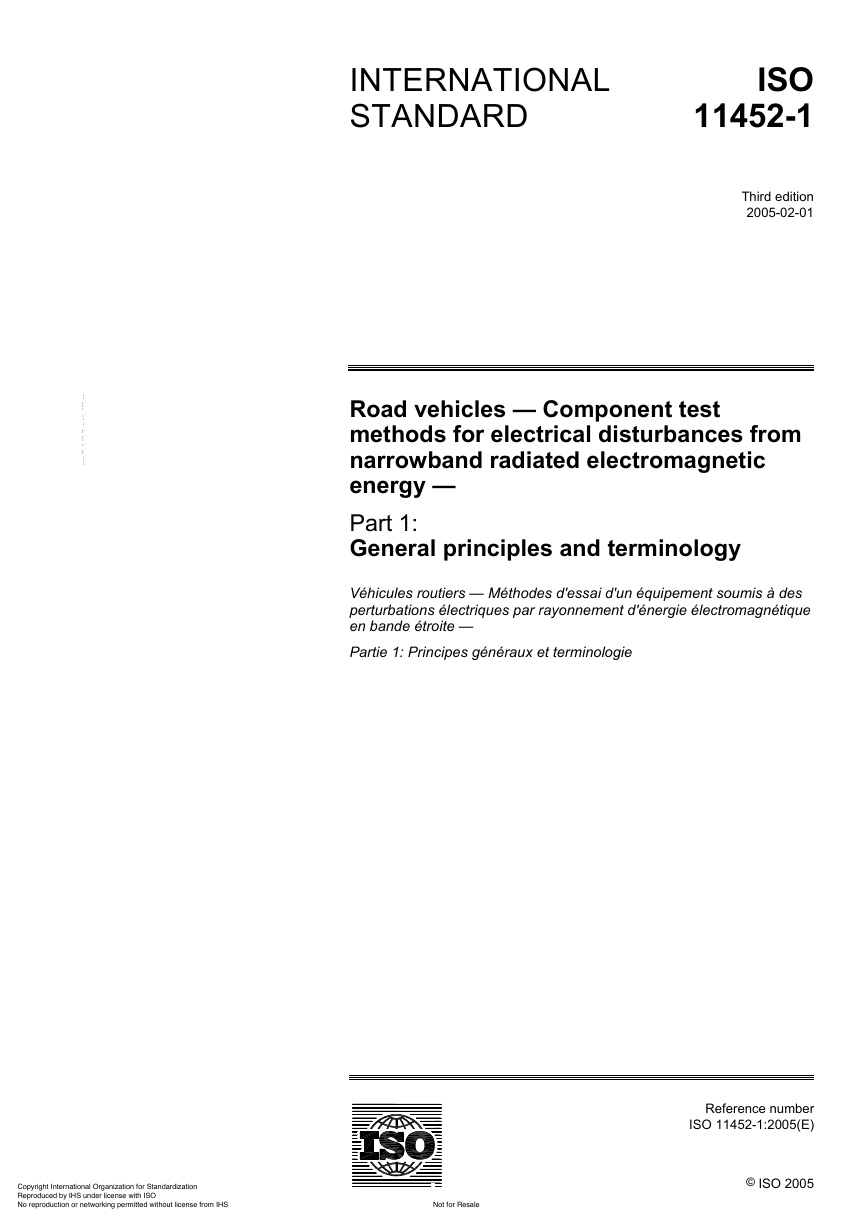
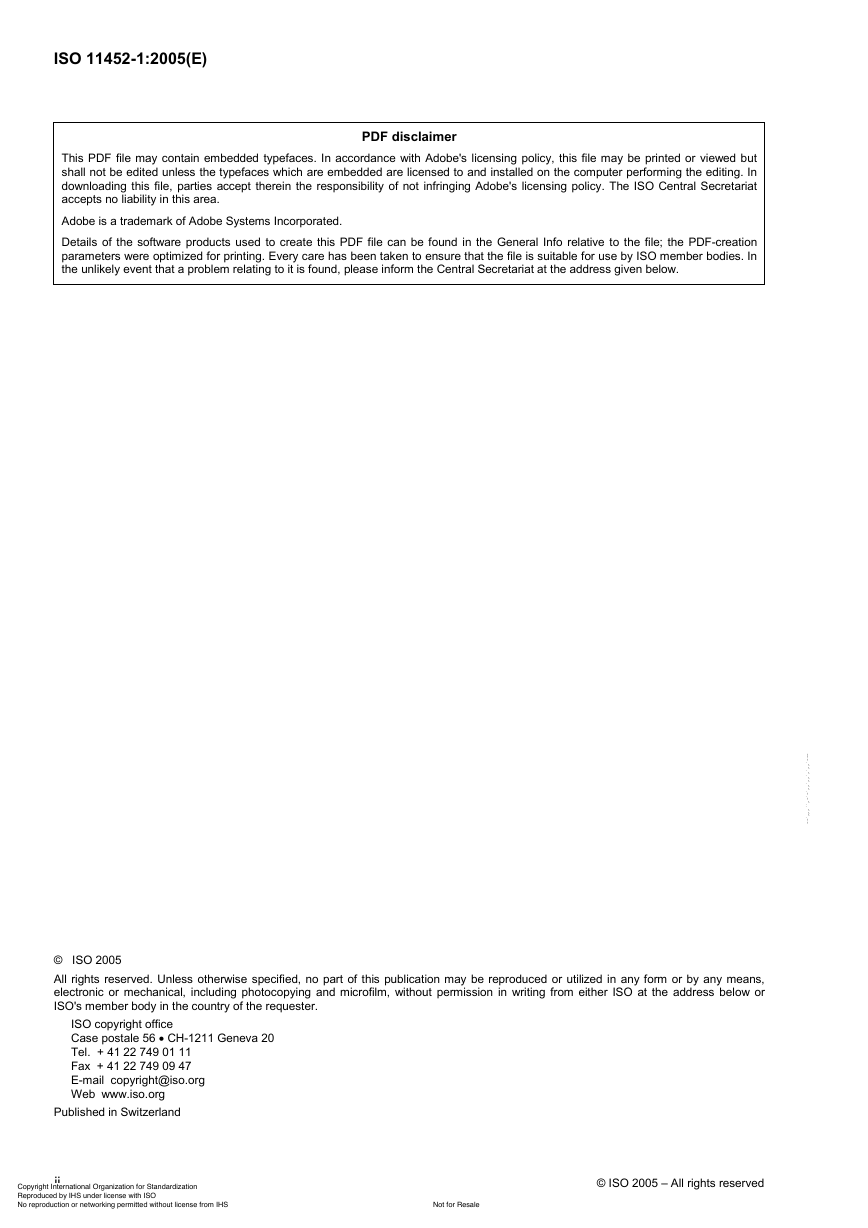
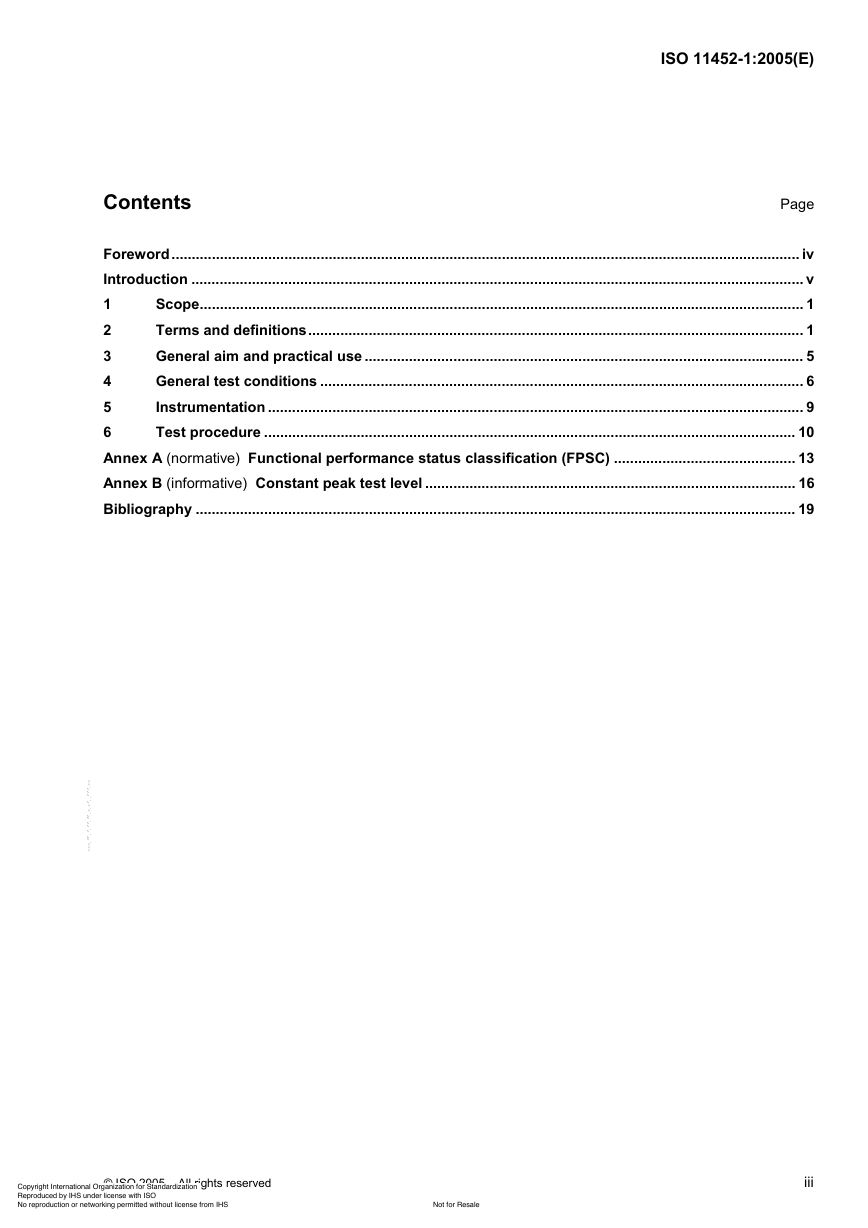
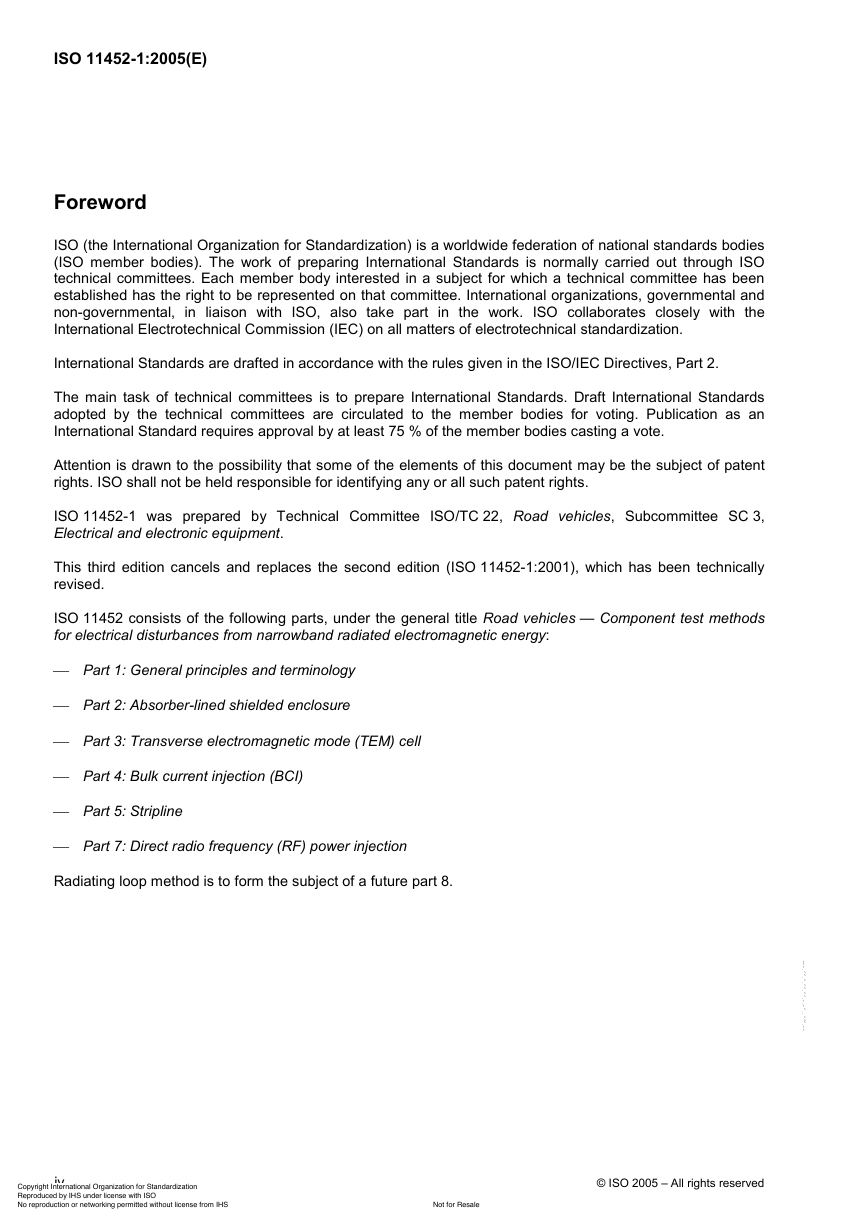
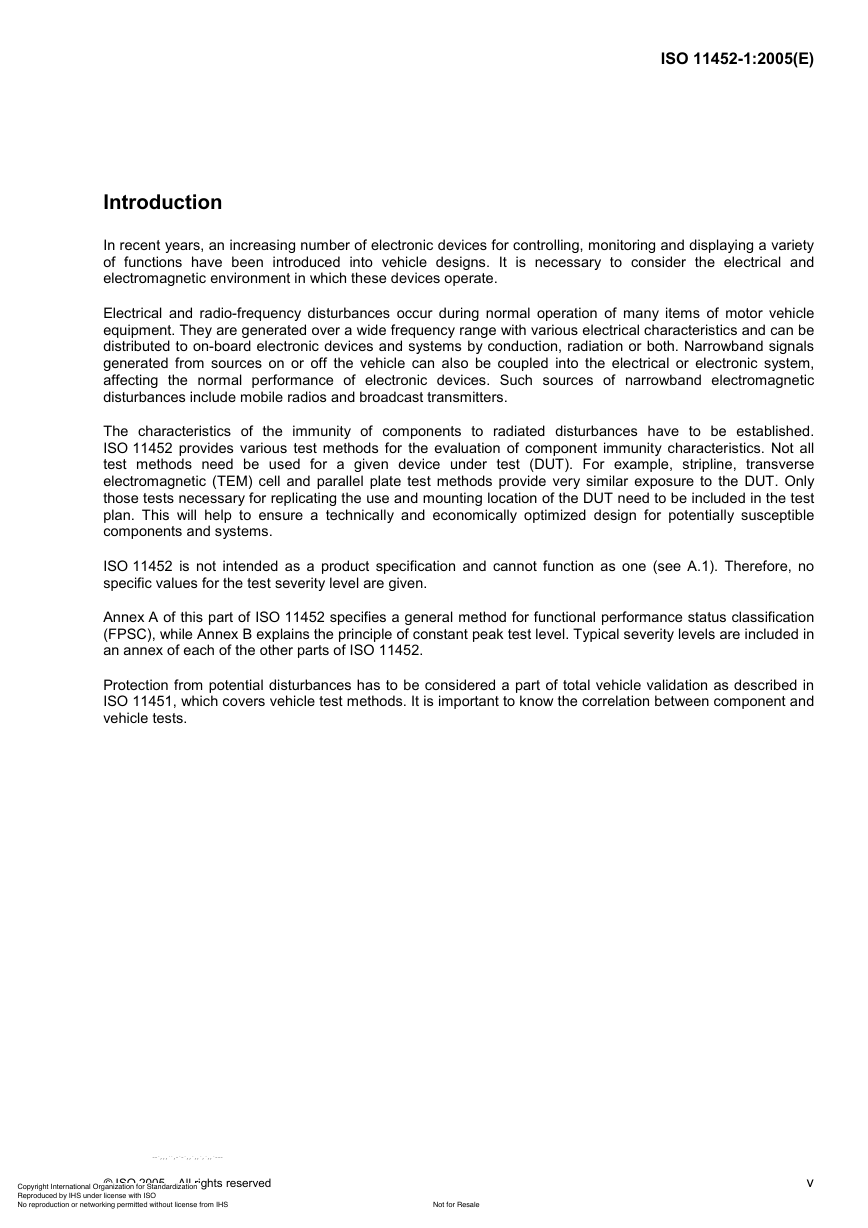


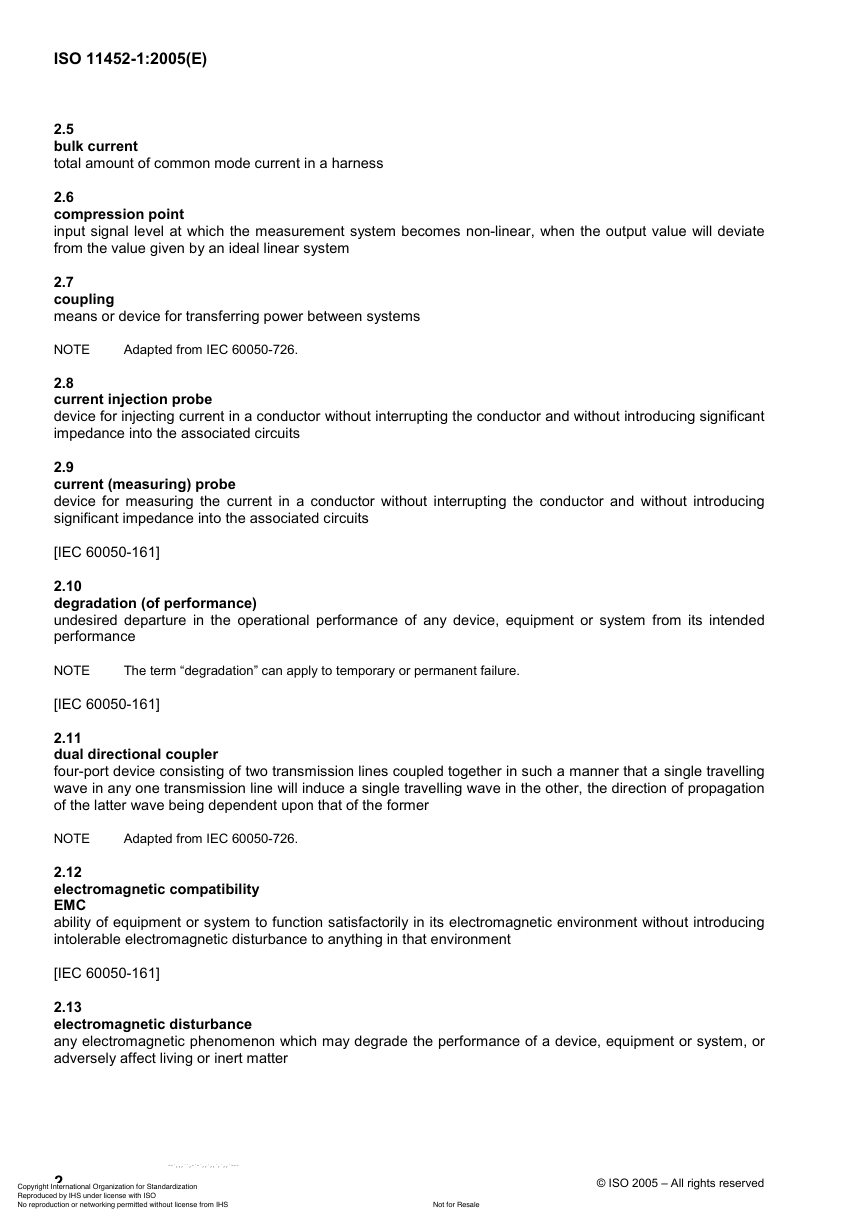








 2023年江西萍乡中考道德与法治真题及答案.doc
2023年江西萍乡中考道德与法治真题及答案.doc 2012年重庆南川中考生物真题及答案.doc
2012年重庆南川中考生物真题及答案.doc 2013年江西师范大学地理学综合及文艺理论基础考研真题.doc
2013年江西师范大学地理学综合及文艺理论基础考研真题.doc 2020年四川甘孜小升初语文真题及答案I卷.doc
2020年四川甘孜小升初语文真题及答案I卷.doc 2020年注册岩土工程师专业基础考试真题及答案.doc
2020年注册岩土工程师专业基础考试真题及答案.doc 2023-2024学年福建省厦门市九年级上学期数学月考试题及答案.doc
2023-2024学年福建省厦门市九年级上学期数学月考试题及答案.doc 2021-2022学年辽宁省沈阳市大东区九年级上学期语文期末试题及答案.doc
2021-2022学年辽宁省沈阳市大东区九年级上学期语文期末试题及答案.doc 2022-2023学年北京东城区初三第一学期物理期末试卷及答案.doc
2022-2023学年北京东城区初三第一学期物理期末试卷及答案.doc 2018上半年江西教师资格初中地理学科知识与教学能力真题及答案.doc
2018上半年江西教师资格初中地理学科知识与教学能力真题及答案.doc 2012年河北国家公务员申论考试真题及答案-省级.doc
2012年河北国家公务员申论考试真题及答案-省级.doc 2020-2021学年江苏省扬州市江都区邵樊片九年级上学期数学第一次质量检测试题及答案.doc
2020-2021学年江苏省扬州市江都区邵樊片九年级上学期数学第一次质量检测试题及答案.doc 2022下半年黑龙江教师资格证中学综合素质真题及答案.doc
2022下半年黑龙江教师资格证中学综合素质真题及答案.doc